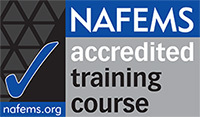Understand, implement, and get the most out of explicit dynamic simulation methods.
10 Steps to Successful Explicit Dynamic Analysis
Specialised design problems involving short-duration high-pressure loadings generally require the use of explicit dynamics methods to obtain a good answer within reasonable time scales. These problems generally simulate severe loading and material failure, from events such as impact, blast loading, car crash, etc. Some manufacturing simulations in which there is changing contact between components with the material undergoing vast deformation also use explicit dynamics methods, such as metal forging, sheet metal pressing, etc.
Proving the necessary inputs and checking the results is important but often the real source of errors encountered in the simulation is difficult to determine.
This course provides a basic overview of explicit dynamics simulation methods, briefly describing the theoretical nature together with its software implementation and its advantages and disadvantages. It should help engineers carry out explicit dynamics simulations, ensuring accurate and robust solutions with correct analysis choices avoiding possible pitfalls. It should also help engineers distinguish problems that should be solved explicitly or implicitly, thereby providing the least time to obtain a solution.
Attending will explain the solution steps to carry out an explicit dynamic analysis, some of these being different to standard analyses such as controlling the hourglass modes,assigning damping and optimizing the computer time. Issues related to contact definition and avoiding extreme mesh deformation are also described.
Interaction is encouraged throughout the course. Questions and class participation are encouraged, as this is one of the key aspects of making this a unique and positive experience for each attendee.
Why an E-Learning class?
Travel and training budgets are always tight! The e-Learning course has been developed to help you meet your training needs.
If your company has a group of engineers, or specific training requirements across any subjects, please contact us to discuss options.
Course Program?
This course combines information, examples, case studies and time for open discussion of the concepts presented.
- Brief theoretical background of Explicit Dynamics
- Material modelling
- Modelling boundaries including contact
- Hourglassing and element selection
- Time stepping and mass scaling
- Simulation considerations
- Typical results
- Examples in typical sectors distributed throughout the course (e.g. manufacturing, impact, explosion)





